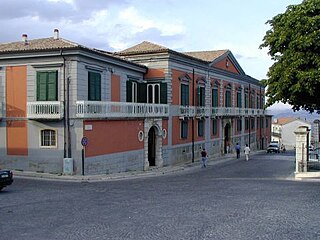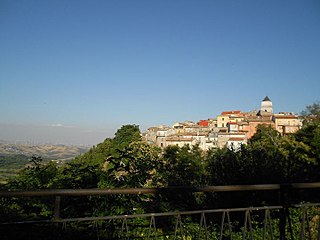Mefitis is the Samnite goddess of the foul-smelling gases of the earth. The Samnites occupied central Italy before the rise of Rome. Mefitis was worshipped in central and southern Italy before Roman times, with her main shrine in the volcano Ampsanctus in Samnium. There was a temple dedicated to her in Cremona, and another on the Esquiline Hill in Rome. It is theorized that Mefitis was originally a goddess of underground sources, such as natural springs—the fact that many of these springs were sulfurous led to her association with noxious gases. She is almost always identified with volcanoes, having been worshipped at Pompeii. Her name, which likely means "one who smokes in the middle", is also seen as Mephitis.

Avellino is a town and comune, capital of the province of Avellino in the Campania region of southern Italy. It is situated in a plain surrounded by mountains 47 kilometres (29 mi) east of Naples and is an important hub on the road from Salerno to Benevento.

The Province of Avellino is a province in the Campania region of Southern Italy. The area is characterized by numerous small towns and villages scattered across the province; only two towns have a population over 20,000: its capital city Avellino and Ariano Irpino.

Bibbiena is a town and comune in the province of Arezzo, Tuscany (Italy), the largest town in the valley of Casentino. It is located 60 kilometres (37 mi) from Florence, 30 kilometres (19 mi) from Arezzo, 60 kilometres (37 mi) from Siena, and 20 kilometres (12 mi) from the Sanctuary of La Verna.

Nocera Inferiore is a city and comune in Campania, Italy, in the province of Salerno, at the foot of Monte Albino, 20 kilometres (12 mi) east-southeast of Naples by rail. It has a population of 45,608 inhabitants and a surface of 20.94 square kilometers (8.08 sq mi) thus showing a population density of 2,200 inhabitants per square kilometer. It rises 43 metres above the sea level.

Gesualdo is an Italian town in the region of Campania, province of Avellino. It is called "The city of the Prince of Musicians", in honour of Carlo Gesualdo. It has many palaces, fountains, belvederes, and a historical center, which was partially restored after the Irpinia earthquake in 1980.

Monte Sant'Angelo is a town and comune of Apulia, southern Italy, in the province of Foggia, on the southern slopes of Monte Gargano.

Bisaccia is an Italian town and comune, population 4,382, situated in the province of Avellino. It borders the communes of Andretta, Aquilonia, Calitri, Guardia Lombardi, Lacedonia, Scampitella and Vallata.

Nusco is a town and comune in the province of Avellino in the south of Italy, east of Naples, with c. 4,100 inhabitants. It is situated in the mountains between the valleys of the Calore Irpino and Ofanto Rivers.

Sturno is a town and comune in the province of Avellino, in the Campania region of southern Italy.

Sant'Elpidio a Mare is a town and comune in the province of Fermo, in the Marche region of Italy.

Frigento is a town and comune in the province of Avellino, Campania, Italy. It is located in the Ansanto valley and bordered by the municipalities of Carife, Flumeri, Gesualdo, Grottaminarda, Guardia Lombardi, Rocca San Felice, Sturno, and Villamaina. Its name derives from the Latin word frequentia ("frequency").

Lioni is a town and comune in the province of Avellino, Campania, southern Italy.

Guardia Lombardi, known as La Uàrdia in the Guardiese dialect or Guardiae Longobardorum in Latin, is a small town and comune in the Province of Avellino in Campania, Italy. At an elevation of 998 metres (3,274 ft), it is located in Alta Irpinia in the Apennine Mountains of Southern Italy. It has experienced a number of major earthquakes throughout its history that have devastated the town, and is considered within zone 1 of the Protezione Civile's seismic classification index, indicating very high seismicity.

Sant'Angelo dei Lombardi is a town and comune in the province of Avellino in the Campania region of southern Italy.

Torella dei Lombardi is a town and comune in the province of Avellino, Campania, southern Italy.

Sant'Angelo in Pontano is a comune (municipality) in the Province of Macerata in the Italian region Marche, located about 60 kilometres (37 mi) south of Ancona and about 25 kilometres (16 mi) south of Macerata. It stands in pleasant position with a panoramic view over the adjacent valleys of Ete Morto river and Tenna river.

Irpinia is a district of the Apennine Mountains around Avellino, a town in Campania, South Italy, about 50 km east of Naples. It was the territory of the ancient Hirpini tribe; its extent matches approximately today's province of Avellino.
Pasquale Cascio is an Italian ordinary of the Catholic Church. He currently serves as the Archbishop of Sant'Angelo dei Lombardi-Conza-Nusco-Bisaccia.
Pecorino di Carmasciano, more commonly known as Carmasciano, is an Italian cheese of the Pecorino family of cheeses made from sheep's milk. It has been recognized since 2009 by the Italian Ministry of Agricultural, Food and Forestry Policies as a prodotto agroalimentare tradizionale, abbreviated as PAT. Pecorino di Carmasciano was featured at Expo 2015 in Milan.


















